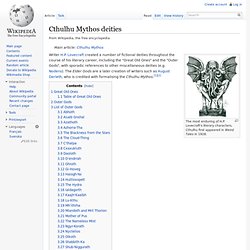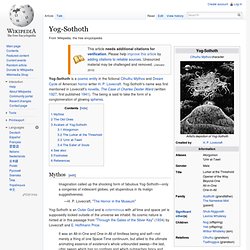

Cthulhu Mythos deities. The most enduring of H.P.

Lovecraft's literary characters, Cthulhu first appeared in Weird Tales in 1928. Great Old Ones[edit] An ongoing theme in Lovecraft's work is the complete irrelevance of mankind in the face of the cosmic horrors that apparently exist in the universe, with Lovecraft constantly referring to the "Great Old Ones": a loose pantheon of ancient, powerful deities from space who once ruled the Earth and who have since fallen into a deathlike sleep.[3] Lovecraft named several of these deities, including Azathoth, Cthulhu, Ghatanothoa, Shub-Niggurath, Yog-Sothoth, Nyarlathotep and Yig. With a few exceptions, Cthulhu, Ghatanothoa, et al, this loose pantheon apparently exists 'outside' of normal space-time. Table of Great Old Ones[edit] This table is organized as follows: In Joseph S. Outer Gods[edit] The Outer Gods are ruled by Azathoth, the "Blind Idiot God", who holds court at the center of the universe.
List of Outer Gods[edit] Abhoth[edit] See Clark Ashton Smith deities. Yog-Sothoth. Yog-Sothoth is a cosmic entity in the fictional Cthulhu Mythos and Dream Cycle of American horror writer H.

P. Lovecraft. Yog-Sothoth's name was first mentioned in Lovecraft's novella, The Case of Charles Dexter Ward (written 1927, first published 1941). The being is said to take the form of a conglomeration of glowing spheres. Mythos[edit] Imagination called up the shocking form of fabulous Yog-Sothoth—only a congeries of iridescent globes, yet stupendous in its malign suggestiveness. Yog-Sothoth is an Outer God and is coterminous with all time and space yet is supposedly locked outside of the universe we inhabit. It was an All-in-One and One-in-All of limitless being and self—not merely a thing of one Space-Time continuum, but allied to the ultimate animating essence of existence's whole unbounded sweep—the last, utter sweep which has no confines and which outreaches fancy and mathematics alike.
Yog-Sothoth knows all and sees all. Azathoth. Azathoth is a deity in the Cthulhu Mythos and Dream Cycle stories of H.

P. Lovecraft and other authors. H. P. Lovecraft[edit] Inspiration[edit] The first recorded mention of Azathoth was in a note Lovecraft wrote to himself in 1919 that read simply, "AZATHOTH—hideous name". Price sees another inspiration for Azathoth in Lord Dunsany's Mana-Yood-Sushai, from The Gods of Pegana, a creator deity "who made the gods and thereafter rested. " Fiction[edit] Aside from the title of the novel fragment, "The Dream-Quest of Unknown Kadath" was the first fiction by Lovecraft to mention Azathoth: [O]utside the ordered universe [is] that amorphous blight of nethermost confusion which blasphemes and bubbles at the center of all infinity—the boundless daemon sultan Azathoth, whose name no lips dare speak aloud, and who gnaws hungrily in inconceivable, unlighted chambers beyond time and space amidst the muffled, maddening beating of vile drums and the thin monotonous whine of accursed flutes.[9]
Cthulhu. Cthulhu[1] is a fictional cosmic entity that first appeared in the short story "The Call of Cthulhu", published in the pulp magazine Weird Tales in 1928.

The character was created by writer H. P. Lovecraft. Spelling and pronunciation[edit] Appearance[edit] In "The Call of Cthulhu", H. Publication history[edit] H. August Derleth, a correspondent of Lovecraft, used the creature's name to identify the system of lore employed by Lovecraft and his literary successors: the Cthulhu Mythos. According to Derleth's scheme, "Great Cthulhu is one of the Water Beings" and was engaged in an age-old arch-rivalry with a designated Air elemental, Hastur the Unspeakable, described as Cthulhu's "half-brother".[13] Based on this framework, Derleth wrote a series of short stories published in Weird Tales 1944–1952 and collected as The Trail of Cthulhu, depicting the struggle of a Dr.
Derleth's interpretations have been criticized by Lovecraft enthusiast Michel Houellebecq.